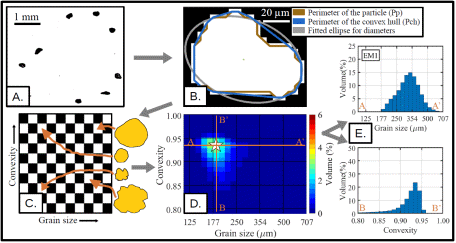J.A. van Hateren1, U. van Buuren1, S.M. Arens2, R.T. van Balen1,3, M.A. Prins1
1 Vrije Universiteit Amsterdam,
2 Bureau for Beach and Dune Research
3 TNO-Geological Survey of the Netherlands
Introduction
The way in which sediment is transported (creep, saltation, suspension), is traditionally interpreted from grain size distribution characteristics. However, the grain size range associated with transitions from one transport mode to the other is highly variable because it depends on the amount of transport energy available. In this study we present a novel methodology for determination of the sediment transport mode based on grain size and shape data from dynamic image analysis (DIA).
Methods & approach
The DIA data are integrated into grain size-shape distributions (Fig. 1) and primary components are determined using end-member modelling. In real-world datasets, primary components can be interpreted in terms of different transport mechanisms and/or sediment sources. The new method is tested on surface and sand trap sediment samples from an active aeolian system in the Dutch coastal dunes (National Park 'Kennemerland'). Aeolian transport processes and geomorphology of these type of systems are well known and can therefore be linked to the spatial distribution of end members to assess the physical significance of the method's output.
Results & conclusions
The grain size-shape distributions of the dune dataset are unmixed into three primary components. The spatial distribution of these components is constrained by geomorphology and reflects the three dominant aeolian transport processes known to occur along a beach-dune transect: bedload on the beach and in notches that were dug by man through the shore-parallel foredune ridge, modified saltation on the windward and leeward slope of the intact foredune, and suspension in the vegetated hinterland. The three transport modes are characterised by distinctly different trends in grain shape with grain size: with increasing size, bedload shows a constant grain regularity, modified saltation a minor decrease in grain regularity and suspension a strong decrease in grain regularity. These trends, or in other words, the shape of the grain size-shape distributions, can be used to determine the transport mode responsible for a sediment deposit. Results of the method are therefore less ambiguous than those of 'traditional' grain-size distribution end-member modelling, especially if multiple transport modes occur or if primary components overlap in terms of grain size but differ in grain shape.

Figure 1 (A) Binary image of sediment grains. (B) Computation of particle characteristics. (C) Assignment of grains to size-shape classes. (D) Grain size-shape distribution (SSD). Star marker designates the mode of the distribution. (E) Grain size (upper panel) and grain shape (lower panel) cross-sections through the SSD along respectively A-A' and B-B'.
I. Surname1*, F.N. Another-Surname2 , Y. Next-Surname2
1 University Name, Country; 2 Organization Name, Country
* Corresponding author: mail.name@organization.org


